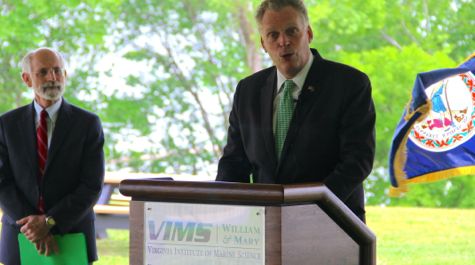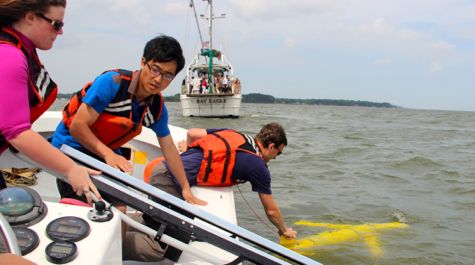Governor visits VIMS to sign stormwater management bill
Law will help rural localities reduce nutrient runoff
Governor Terry McAuliffe visited the Virginia Institute of Marine Science on Thursday for a ceremonial signing of the General Assembly’s recent stormwater management bill.
The bill provides assistance from the Commonwealth’s Department of Environmental Quality to the mostly rural localities that have chosen not to establish their own stormwater management programs, commonly due to concerns about the funds and resources needed to draft, implement, and enforce such pollution-reduction measures.
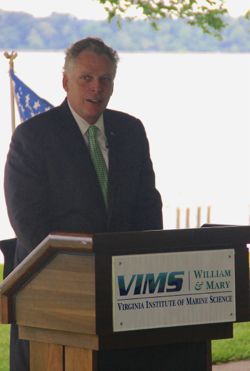 The bill also defers for six months from July 1st the requirement that certain localities establish a stormwater management program—namely the cities and counties that have only recently attained a population density requiring adoption of a municipal storm-sewer system.
The bill also defers for six months from July 1st the requirement that certain localities establish a stormwater management program—namely the cities and counties that have only recently attained a population density requiring adoption of a municipal storm-sewer system.
In his comments before signing the legislation, McAuliffe said, “This was as complex and stormy an issue as you could have, and I want to thank everyone who sat around the table. I know that sometimes the negotiations had gotten very intense, but you came together to do the right thing for the Commonwealth of Virginia and the best interests of the Bay.”
Joining the Governor for the ceremony were Senator Emmett W. Hanger, Jr., patron of the bill’s Senate version (SB 423), Secretary of Natural Resources Molly Ward, and other state officials. Delegate Keith Hodges, patron of the bill’s House version (HB 1173), was unable to attend. The House and Senate versions of the bill are essentially identical.
After citing the Commonwealth’s recent success in dealing with pollution from point sources like sewage treatment plants, Hanger noted that stormwater is “a huge issue with a huge price tag that we’ve been unable to address comprehensively” to date. But, he says, the stormwater bill “provides significant policy changes” and helps put in place the structures needed to tackle pollution from stormwater and other non-point sources. He thanked the McAuliffe administration “for being steadfast in their commitment to clean water and the revised Bay cleanup plan.”
VIMS Dean and Director John Wells introduced the dignitaries and hosted them on a subsequent tour of the York River aboard the VIMS research vessel Bay Eagle. He says, “We were pleased that the Governor thought of VIMS when choosing a venue for signing this important bill. Helping Virginia’s localities reduce the runoff of nitrogen and other pollutants is a key part of state and federal efforts to restore Bay health, and an area where VIMS scientists have significant experience and expertise.”
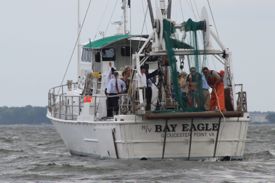 Indeed, during the boat trip, Governor McAuliffe discussed Bay science with several of the VIMS researchers involved in monitoring water quality, environmental conditions, and populations of finfish and other marine life in Bay waters.
Indeed, during the boat trip, Governor McAuliffe discussed Bay science with several of the VIMS researchers involved in monitoring water quality, environmental conditions, and populations of finfish and other marine life in Bay waters.
Professor Ken Moore spoke with the Governor and colleagues about the enhanced monitoring tools—including boat-mounted sensors, towed undulating vehicles, and vertical profilers—that give today’s researchers the ability to map with unprecedented detail how environmental parameters such as temperature, salinity, oxygen, and nutrient levels vary in space and time.
Assistant Professor Donglai Gong then deployed one of his unmanned underwater gliders for a first-hand look at how these next-generation vehicles allow for data gathering during extended missions over large regions. Assisting were VIMS Captain and Marine Safety Officer Jim Goins and graduate students Nicole Marshall, Alex Renaud, and Haixing Wang.
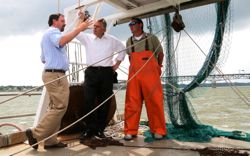 The third VIMS scientist, Professor Rob Latour, joined with Captain John Olney, Jr., Marine Superintendent Durand Ward, and first mate Keith Mayer to conduct a short trawl tow—the main tool that Latour and colleagues use to monitor changes in the abundance and distribution of commercially, recreationally, and ecologically important fishes in Bay and coastal waters. Latour stressed the connection between good water quality and the health of Bay fisheries.
The third VIMS scientist, Professor Rob Latour, joined with Captain John Olney, Jr., Marine Superintendent Durand Ward, and first mate Keith Mayer to conduct a short trawl tow—the main tool that Latour and colleagues use to monitor changes in the abundance and distribution of commercially, recreationally, and ecologically important fishes in Bay and coastal waters. Latour stressed the connection between good water quality and the health of Bay fisheries.
During the boat tour, McAuliffe also spoke with Wells concerning VIMS’ proposal to establish a monitoring program that would combine data from the types of cutting-edge field instruments they had just observed with next-generation computer models to help assess and verify the effectiveness of public expenditures for stormwater management.
“Virginians support the concept of restoring and maintaining a healthy Bay,” says Wells, “but they need to be assured that the targeted actions are effective. Our obligation to achieve the federally mandated pollution diet—the Total Maximum Daily Loads or TMDLs—falls particularly hard on local governments, which face difficult choices for the allocation of scarce resources. The stormwater bill leverages state resources to help rural and rapidly growing localities with these challenges, and our proposed monitoring program would help verify the Commonwealth’s return on investment.”
Wells explains that Virginia and other Bay states have to date relied on the Chesapeake Bay Program’s model and monitoring data to assess progress towards their federal water-quality goals. “These tools are the best we’ve had,” he says, “and they’ve played a key role in guiding and tracking the initial gains we’ve made baywide.”
“But,” Wells adds, “as the focus of Bay cleanup shifts to smaller watersheds and local governments, there is a clear need for enhanced modeling and monitoring of remediation efforts and water quality in Virginia’s waters. By combining our advanced monitoring technologies with our state-of-the-art modeling capabilities, we feel we are well positioned to meet this critical need head-on.”
VIMS is mandated in the Code of Virginia as the scientific advisor to the Commonwealth on marine and coastal natural-resource issues. William & Mary’s School of Marine Science is VIMS’ graduate education component.


